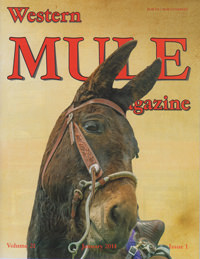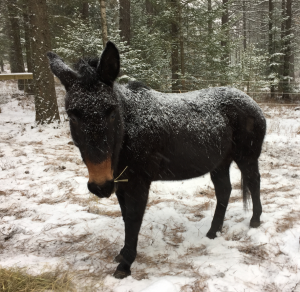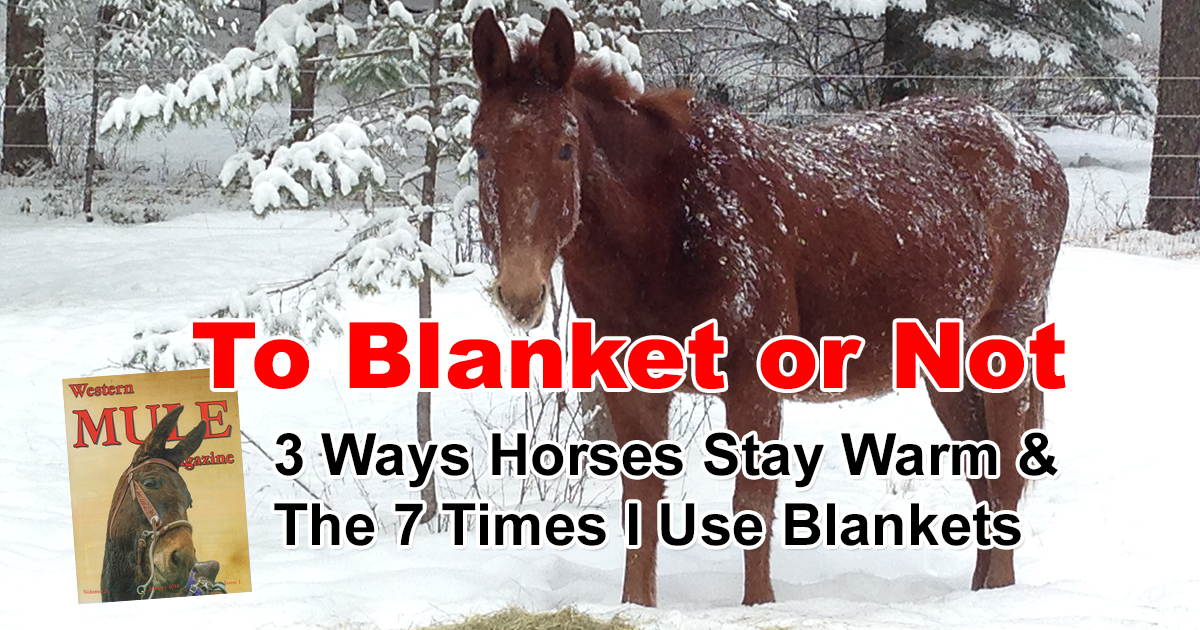 Blanketing your Horse and Mule
Blanketing your Horse and Mule
As I write this it’s twenty nine degrees and snowing. While I’m inside snug and cozy by the fire the beasts are outside with a blanket of snow covering their furriness. During the winter months, despite multiple layers I’m constantly chilled as I feed, care for and ride my animals and I frequently wonder if I should pull out the blankets. I’ve a feeling that I’m not the only one wondering about blanketing. Rather than give you hard and fast “rules” about when and when not to blanket I’ve developed some guidelines that can help us to determine what’s best for your mule and your particular situation.
Before we consider the blanket let’s think about the animal. Equines are masters at staying quite comfy in weather that sends us running for our coats. That being said; you cannot determine a mules’ need for a blanket by how chilly you feel.
So how do our furry friends stay warm?

No need for blankets on Ellie
The primary method that keeps a mule warm is eating. Yes, that favorite activity is actually keeping him warm. Heat is a by-product of the digestion process so on a frigid night the first thing we should think of is providing our beasts with plenty of hay to keep that equine furnace burning. This internal furnace is centered in the mules hindgut where microbes convert the fiber in hay into energy with heat created as a byproduct. It’s pretty darn nifty process if you ask me. Of course the digestion process also needs water to keep running so make sure to keep the H2O ice free and even better not ice cold.
A secondary characteristic that helps keep the cold at bay is the size of the animal. While you could borrow your kids’ science book for a physics primer on why this is, it’s easier to think of a large block of ice that takes longer to thaw than a smaller chunk; a large warm body stays warmer longer than a small one.
We share the third winter warmth feature with our trail partners, although they’re much more efficient than we are. Horses and mules use the same process that we call Goose Bumps to stay warm. The tiny muscles attached to each hair follicle contract and causes hair strands to literally “stand on end.” This creates a surprisingly warm layer of air around the animal. If you don’t believe that you’ve never held your hand under a mane on a cold day. The reason behind this is another physics lesson on the second law of thermodynamics. This layer of warm air is essentially the same as the loft in a sleeping bag. Did you know that a blanket can actually make your mule colder by squashing this natural insulating layer of hair? If you compress that loft with a heavy blanket and remove the air voids and he can get cold in a quick way. Keep that in mind in borderline situations where he may actually be more comfortable wearing his natural blanket than a store-bought one.
So even though it may be frigid out; if your mule is in good condition, eating plenty of roughage, and wearing his own hair coat he’s probably going to be toasty warm-as long as he can stay dry and isn’t in direct wind.
Now that we’ve discussed a perfect world let’s talk about the less than optimum world that we live in.
Here’s a great quote from the docs at the Veterinary Medicine and Biomedical Sciences Department at Texas A&M University. “For the vast majority of horses, it will never be too cold for them to live outside with no blanket,” “Horses survive in very harsh winter environments with their natural hair coat. Those horses that would benefit from blanketing are those that are thin, debilitated, ill, or have no natural hair coat.”
Not every mule has a wooly warm coat. Some breeds have naturally thin coats, and others have thin coats from blanketing, living in a warm climate or barn, or whose coat has been clipped. You’ll also have to consider if the animal is underweight, isn’t eating enough roughage, isn’t able to get out of the wind or wet, or has a health concern that compromises his ability to stay warm. The further you get from optimum the more you should consider adding a blanket.
On the furthest reaches of optimum is the case of show animals that are kept artificially thin coated to be ready for presentation, these animals should certainly have a blanket to help them stay warm in winter.
Closer to home for trail riders is the case of wind and rain. The weather is rarely optimal; when it is, wait a few minutes and it’ll change. Being a former Seattle dweller I’m used to months of rainy days that hovered in the low 40 degree range. Wet animals lose body heat very quickly as the wind increases and temperatures drop. Snow is not as hard on our friends as an icy rain because a layer of snow on the horses back acts as an insulator. For our animals in this environment we chose to avoid blankets when we could and instead opted for shelters that they could use to escape the rain and wind.
When I’m considering blanketing these are the guidelines I consider before I pull the blankets out.
- Is the animal visibly uncomfortable or shivering?
- Is he older, weak, ill or recovering from an illness?
- Is he very young?
- Is he clipped?
- Is he going to be shown?
- Is he lacking a sufficient winter coat?
- Did he recently move from a warmer climate to a cooler climate?
If the answer is yes to any of these I’ll put a blanket on. If not I don’t bother and the mule is more content and much happier as a result.
As always for more information on this and other topics of note for horse and mule owners, as well as North Americas largest directory of equine trails and camping areas please visit www.TrailMeister.com.


